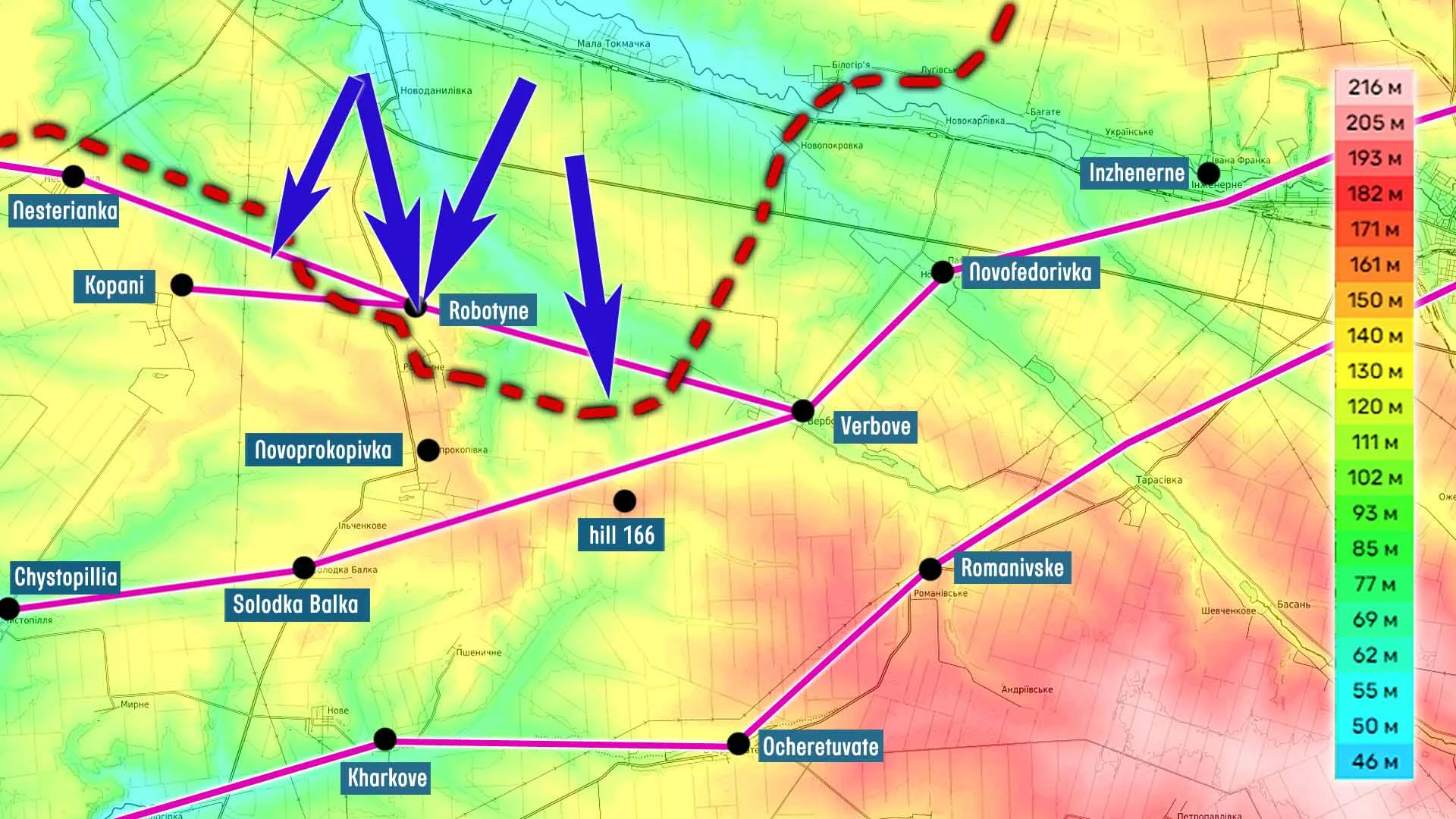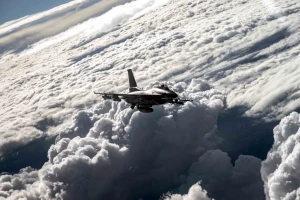
Ukraine progresses in Zaporizhzhia region, opening way to Tokmak - military expert Serhiy Zgurets
Tokmak is a crucial logistics hub controlled by the Russians. Notably, the enemy has established a circular defense there. It is crucial to remember that there is still about 19 kilometers of heavy offensive before reaching this town
Ukraine’s success near Robotyne
On August 22, the Armed Forces' General Staff reported a significant success by our military in the Robotyne area of the Zaporizhzhia region. Members of the 47th separate mechanized brigade shared a video showing the evacuation of civilians from the village of Robotyne using Bradley armored personnel carriers
The soldiers noted that after two months of intense fighting, they managed to break through the enemy's defensive line. This likely refers to the advancement of our forces within Robotyne itself and the areas between Robotyne and Verbove. The enemy forces admitted to withdrawing not only from a significant portion of Robotyne but also from several strongholds near Verbove. This suggests that our Armed Forces likely hold control over the northern and central parts of the village. However, it's important to note that full liberation is not confirmed yet. As of around 3:00 p.m., our military reported the presence of Russian units on the southern outskirts of Robotyne, indicating the need for further efforts to completely secure the village.
Furthermore, our units, including National Guard brigades, are exerting pressure on the enemy along the highway toward Novopokrovka, located to the east of Robotyne. This pressure on the enemy is expanding, and it's worth mentioning that the enemy had allocated substantial forces and resources to maintain their defense line spanning from Kopani through Robotyne to Verbove.

Enemy reserves have been actively targeted and destroyed in this region. While the enemy suffered significant losses, it's not yet conclusive that the Russian defense is on the verge of collapse. The invaders strategically retreated, preventing encirclement and complete annihilation. Presently, the enemy appears to be attempting to establish a foothold behind the village, potentially preparing for counter-offensive actions. In response, our artillery is consistently engaging the enemy's support lines based in Novoprokopivka and further south of Robotyne.
The primary defensive line of the enemy, fortified with strongholds, extends from Novoprokopivka and is the main barrier. It's foreseeable that our artillery will continue to target these fortified positions to greatly assist our brigades' advancement.
The capture of Robotyne, followed by Novoprokopivka, and breaching the main enemy defense line, paves the way to Tokmak, a crucial logistics hub currently encircled by the enemy. However, it's important to acknowledge that around 19 km of challenging terrain still separates us from Tokmak. Another noteworthy detail is that nearly all foreign equipment received by the Ukrainian Armed Forces passes through Robotyne. Initially, it was the 47th brigade with Leopard and Bradley equipment, and now the 82nd brigade is operational there, equipped with British Challenger tanks, German Marder IFVs, and American Stryker APCs.
Swedish Combat Vehicle 90 (CV 90)
During a recent visit to Sweden, the President of Ukraine announced a plan to produce the CV 90 IFV (infantry fighting vehicle). This project had been previously mentioned, with reports in June indicating Ukraine's readiness to either order or co-manufacture up to a thousand of these IFVs in collaboration with Swedish companies.
Mykola Salamakha, a military expert and reserve lieutenant colonel of the Armed Forces of Ukraine, highlighted that the CV 90 is a robust infantry fighting vehicle initially developed in Britain between 1984 and 1993. Sweden was the original customer, and these IFVs later found buyers in several other countries, particularly in Scandinavia and Estonia. Ukraine also received some of these vehicles as part of material and technical assistance. The strength of the CV 90 lies in its armor protection, featuring spaced steel armor as its foundation. Additional ceramic armor is employed to enhance defense, layered over the primary armor. The design of this IFV was carefully planned to incorporate modular booking options, which can be added for extra protection. In its standard configuration, the CV90's frontal aspect can withstand 30 mm shells from a Soviet cannon and a 25 mm American-made cannon. The sides and rear are safeguarded against 12.7 mm and 14.5 mm calibers, corresponding to Soviet standards. The addition of supplementary booking raises this protection to 30 mm, enabling the CV 90 to withstand 30 mm armor-piercing shells from Soviet-caliber weapons from distances exceeding 1 km.
He further explained that the Soviet Union had long employed a replica of the German multilayer armor found on the Leopard 2-A4 tank. This configuration included specialized armor modules in the frontal section of the T-72B tank and beyond. Hence, this vehicle doesn't introduce anything novel for the Russians. Achieving the technological successes that the British did, starting from 1993 and producing about 1170 units across four versions, is a challenging endeavor. Currently, there's talk of the British preparing to collaborate on a fourth series. The CV90 stands as one of the premier IFVs globally. If Ukraine teams up with Sweden to manufacture even the third version of the CV90, it will signify a significant advancement in our Armed Forces' capabilities, particularly in terms of heavy-class IFVs. The vehicle boasts an exceptionally potent fire control system, allowing the deployment of three different caliber cannons. Each of these gun types can use fragmentation and armor-piercing projectiles, as well as programmable detonation projectiles while in flight.
Strikes on the Russian strategic aviation bases
Shifting our focus to the skies, our drones have been conducting successive attacks on Russian bases and airfields where enemy Tu-22M3 bombers are stationed. Over the past few days, these strikes have resulted in significant damage. On both August 19 and 21, attacks on Soltsy and Shaykovka airfields led to the complete destruction of two Tu-22M3 strategic bombers, while two additional planes sustained damage. This information has been sourced from Ukrainian intelligence insiders.
Aviation expert Anatoliy Khrapchynskyi has highlighted two critical factors behind the destruction of these strategic aircraft. First, there's a psychological impact, striking at the core of the Soviet nuclear triad. Remarkably, Russia hasn't introduced any entirely new strategic aircraft since the Soviet era; its efforts have mainly centered on modernization. Second, there's a strategic motive. Given the Russian Federation's tendency to target our energy facilities during the cold season, pushing back enemy strategic aviation is crucial. This extended approach time enhances our response capabilities and strains the enemy's operational capacity. Notably, the Soviet Tu-22M3 aircraft were already close to exhaustion in terms of their operational lifespan, magnifying the consequences of these targeted attacks.
Khrapchynskyi further explains that the Shaykovka airfield is approximately 230 km away, Engels is roughly 550 km distant, and the Soltsy air base is over 700 km away. Consequently, the Olenya air base beyond the Arctic Circle on the Kola Peninsula is relatively closer than expected. Russian attempts to relocate their strategic aviation to distant locations, as they've done in the past, may not be as effective in the present circumstances.
Regarding Ukraine's adoption of the F-16, Khrapchynskyi emphasizes that the least challenging aspects are pilot training and equipment. The country already possesses suitable infrastructure, with a need to reinforce security measures. Bases hosting these aircraft must be fortified with air defense systems. Notably, Ukraine can utilize the F-16 within its borders, as Western weaponry is provided with conditions for use on Ukrainian soil. With the existing arsenal, we have the capability to liberate occupied territories and execute strikes similar to those against the Russian strategic aviation bases.
- News













































